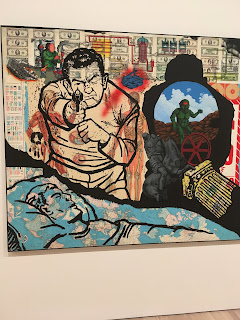Bruce Nauman is an American artist known for his works of neon lights, paintings, sculptures, photographs, and drawings. He used neon lights to create words and other figures. In "One Hundred Live and Die" this art consist of inspiring and yet hurtful words. It's vibrant, almost like a neon rainbow of words, and expresses different relatable emotions. It depicts and plays with neon colors, human emotions about life and death in the 100 words shown with 4 columns, and in a pattern. The words illustrate different actions from left to right.
The materials are neon tubing and clear glass tubing on metal. There are words such as "live, die, suck, yellow, etc." Each column lights up on by one, then a sentence may light up or a word, but you have to wait a while until all the columns light up. In "Light Trap for Henry Moore" Nauman has a black and white (time lapse) photograph. He twirled around a flashlight in a dark room to make the shape of a seated body. The body is trapped in this cage, and that body is Henry Moore. Nauman dedicated this to Moore since he saw him as a "modern master".













